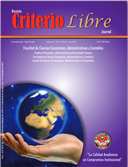Incentives in the scheme of social security in colombia: an economic essay
DOI:
https://doi.org/10.18041/1900-0642/criteriolibre.2010v8n12.1259Keywords:
National Health Service, economy of the information, economic measurementAbstract
The aim of this document is to outline the used methodologies and the results obtained as for the measurement of the impact of the cost of social security on the employment and later, to outline the theory and technical methodologies that allow to evaluate the incentives of the agents (signatures and persons) to realize the contributions to the social security. To be able to fulfill such an aim, this scheme is divided in 5 sections, being the first this introduction. In the second section is presented the conceptual frame proposed to analyze the scheme of incentives of the agents (signatures and persons) to realize the above mentioned contributions. In the third section it is analyzed in detail the scheme of incentives of the persons as for the insurance in health and finally as a conclusion, the elements of a mechanism of ideal insurance are mentioned.
Downloads
References
Bernheim, H. (1996). Rethinking Saving Incentives. Stanford Working Paper No. 009.
Bernheim, H. (1999). "Taxation and Saving", Handbook of Public Economics, Elsevier.
Bolton, R. and Dewatriport, R. (2005). Contract Theory. MIT University Press.
Bowman, M. et al (1999). "Loss Aversion in a Consumption-Savings Model", Journal of Economic Behavior and Organization 38(2).
Campbell, D. (2005). Incentives. Second Edition. Cambridge University Press.
Conslik, K. (1996). "Why Bounded Rationality?", Journal of Economic
Literature.
Cutler, R. and Zeckhauser, M. (2000). The Anatomy of Health Insurance. Handbook of Health Economics, Chapter 11. Elsevier.
Furubutn, E. and Richter, M. (2008). Institutions and Economic Theory. Second Edition. University of Michigan Press.
Gibbons, R. (2003). Un Primer Curso en Teoría de Juegos. Antoni Bosh.
Haas, T. (1995). Incentives and Financing Methods. Health Policy, 34.
Hammermesh, W. (1986). The Static Demand for Labor. Handbook of Labour Economics. Vol I. Chapter 8.
Laffont, J. and Maskin, E. (1982). Advances in Economic Theory. Cambridge University Press.
Laibson, H. et al (1998). "Self Control and Retirement Saving", Brookings Papers on Economic Activity 1, 91-196.
Macho-Stadler, M. and Pérez-Castillo (2001). An Introduction to Economics of Information. Second Edition. Oxford.
Madrian, H. (1999). "The Power of Suggestion: Inertia in 401(k) Participation and Savings Behavior", NBER Working Paper 7682.
Nicholson, W. (2004). Teoría Macroeconómica. Thomson Learning. Octava Edición.
Nickell, T. (1986). Dinamic Labour Demand in Long Run. Handbook of Labour Economics. Vol I. Chapter 9.
O'Donoghue, R. and Rabin, H. (1999). "Doing It Now or Later", American Economic Review 89(1), 103-24.
Rabin, J. (1998). "Psychology and Economics", Journal of Economic Literature 36, 11-46.
Rasmusen, E. (2007). Games and Information. Blackwell. Fouth Edition.
Repetto, L. (2001). Incentivos Al Ahorro Personal. Working Paper. CEA- Universidad de Chile.
Rotschild, M. and Stiglitz, J. (1976). Equilibrium in competitive insurance markets: an essay on the economics of imperfect information, Quarterly Journal of Economics 90(4).
Thaler, H. (1981). "An Economic Theory of Self Control", Journal of Political Economy 89(2), 392-406.
Thaler, H. (1994). "Psychology and Savings Policies", American Economic Review Papers and Proceedings 84(2), 186192.
Vidor, T. (2005). The effect of Saving Incentives. Working Paper. Ministry of Finance- Hungary.
Zweifel, J. and Maning, F. (2000). Moral Hazard and Customer Incentives in Health Care. Handbook of Health Economics, Chapter 8. Elsevier.





